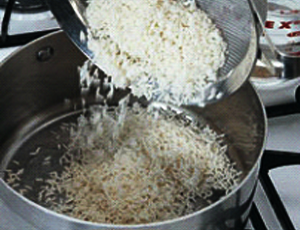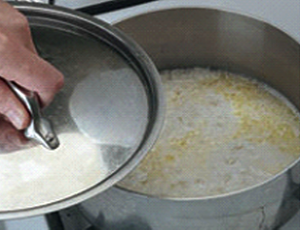Fine Cooking
HOW TO COOK RICE PERFECTLY
It’s seemingly the most basic kitchen task, yet it still bedevils many accomplished cooks: making a perfect pot of Basic, Fluffy White Rice, with each grain distinct and not mushy. It’s not impossible, though, if you know a few secrets: use the right amount of water, gentle heat, a tight-fitting pot lid, and a post-cooking resting period. Be sure not to skip the resting step at the end; as the rice sits off the heat, the moisture in the rice redistributes itself for a more uniform texture throughout the pot.
STEP ONE: RINSE AND (MAYBE) SOAK
I usually rinse my rice in a few changes of cold water. There are two reasons for rinsing: some mills outside the U.S. use talc as a milling aid, so it’s an important step for imported rice. The rinsing also removes loose starch, making the rice less sticky.
For most everyday meals, you can get good results without soaking your rice. If I’m using older rice, I soak it for about 30 minutes, which makes the grains less brittle and prone to breakage. Soaking is also traditional for basmati rice, as it helps the rice expand to maximum length. Either way, be sure to drain your rice thoroughly or you’ll be using more water in cooking than you intended.

STEP TWO: A SIMPLE COOKING METHOD
There are many different methods for cooking rice, but the simplest is the absorption method: the rice is cooked in a measured amount of water so that by the time the rice is cooked, all the water has been absorbed. As the water level drops, trapped steam finishes the cooking.
The key to this method is figuring out the correct amount of water. As a general rule, use 1-1/2 to 1-3/4 cups of water per cup of long-grain white rice, but you may need to experiment a little to find the amount you like best. Brown rice require more water, while shorter-grain rice require less. Keep in mind that more water gives you softer, stickier rice—great for stir-fries. Less water results in firmer rice, a good style for rice salads. The other important element is a heavy-based pot (to prevent scorching on the bottom) with a tight-fitting lid that keeps the steam in. If your lid fits loosely, put a clean kitchen cloth between the lid and the pot.

STEP THREE: LET IT REST
After about 12 minutes, the liquid should be absorbed, and the rice al dente. If you served the rice now, you’d find the top layer drier and fluffier than the bottom, which can be very moist and fragile. Here’s where you need patience: Let the rice sit off the heat, undisturbed with the lid on, for at least 5 minutes and for as long as 30. This lets the moisture redistribute, resulting in a more uniform texture, with the bottom layers as fluffy as the top.
MANUAL HARVESTING
In many countries rice ears are cut by hand. A special knife is frequently used in SouthEast Asia (“ani-ani”). For instance, in the Casamance region of Senegal rice is cut stem by stem with a knife, 10 cm below the panicle so as to leave straw in the field in amounts large enough to produce grazing for cattle. Nevertheless such practice is labour intensive.
